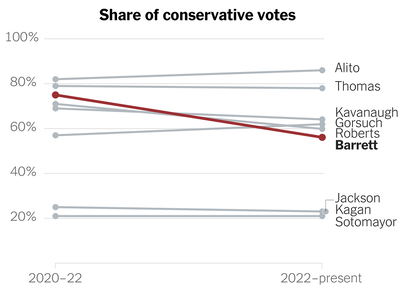1. The Supreme Court had to overrule a truly baffling decision by the 11th Circuit, which seems just incoherently cobbled together. They read the statute incorrectly to eviscerate all exceptions to the FTCA, but that rule would be favorable to plaintiffs. Of course they didn't want THAT, so they created out of thin air a "Supremacy Clause" defense in which the government can prevail if it shows that the officers' conduct (i.e. storming into a house, guns blazing) has "some nexus with furthering federal policy and can reasonably be characterized as complying with the full range of federal law."
That's of course a nonsense consideration. The whole thing is simply weird. That's not how the Supremacy Clause works. But to an aspiring dictator, it's manna from heaven. Sure, the officers committed all sorts of intentional torts, but as long as they were "furthering federal policy" it's OK. Does that sound like anything we've heard recently? You know, "furthering the president's agenda"?
2. So it might come as a surprise that two of the three judges were . . . Trump appointees. Psych. One was Supreme Court shortlister and overall incompetent "judge" Lagoa, who was clearly auditioning for a promotion. The other was just an undistinguished white dude who hates gay people and got the nomination so that he could sit there forever. Ha, joke will be on them when we cancel the circuits and reconstitute them . . .
Actually the only surprise was that a Biden nominee joined that abomination of an opinion. She's finishing up her second year in the job. Maybe she hasn't found her footing yet? I guess there's a weird 11th Circuit precedent from two years ago, but pretty sure the holding in the case is inapposite so it wasn't binding.
3. Anyway, few things depress me more when judges make basic and fundamental mistakes that we wouldn't tolerate from law students. The Supremacy Clause says that federal
law is the supreme law of the land. The 11th Circuit seems to think it does the same thing for every federal policy or enforcement action. So if a state law gets in the way of a federal policy, they think the state law must yield.
It's impossible to overemphasize the ignorance required to reach this holding. It's not only that the Supremacy Clause is clear on its face. It's also that we have a doctrine of field preemption, which outlines the special circumstances in which federal policy can preempt state law -- namely, if Congress intended to "occupy the field" so that Congressional choices about what NOT to regulate have preclusive effect over states that want to regulate. If ever there was a statute not intended to occupy the field, it's this one -- with about 11 exceptions, and then 6 exceptions to the exception, several of which refer expressly to state law, and none of which even purport to displace state law since it's a statute about when the government waives its sovereign immunity.
It's ALSO that we have an anti-commandeering doctrine rooted in the 10th Amendment, which states that federal law cannot conscript state officials into enforcing federal law. That doesn't apply directly, but obviously it would be contradicted by any rule in which a federal desire for state assistance would preempt the state's refusal to provide it.
But how could the 11th Circuit have known it was wrong? Maybe they were just reading the statutes a little more aggressively than I am. Let's see -- oh, every circuit that has ruled on the question came out the other way, with all but one of them unanimous? And now the Supreme Court unanimously overturned?
4. There should be a rule that if you're an appellate judge, and you sign onto a ruling that contradicts every other appeals court and then gets unanimously overturned by the Supreme Court, you need a one year timeout, at a minimum, to pull your head out of your ass.




